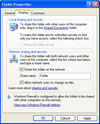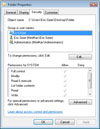Troubleshooting Network Sharing Issues: Part II
In Part 1 of this two-part series, we began performing checks and troubleshooting tasks to resolve sharing issues on our network.
This part concludes by verifying the sharing and files permissions of the folders and files. When they aren't configured correctly, certain users might not be able to access a particular share or they might not receive full access (the ability to modify files) when you want them to.
You'll also discover how to manually access shares, which may give you a possible work-around from the underlying issue.
Finally, if you still have problems, we'll reinstall the adapter and restore the router to factory defaults.
Verify the Sharing Permissions
If you are having problems accessing certain shares or are unable to modify shared files, you should check the sharing permissions. These settings define who can access the shared folder and what they can do with the files (read-only, write, delete, etc).
The way you define the sharing permissions differs between using the basic (default) sharing method and the advanced sharing method you can manually enable.
You can bring up the sharing settings by right-clicking a folder and choosing the sharing option. When verifying these settings, you want to just make sure you have defined what you desire.
If users have only read-only access, and you want them to be able to modify files, make sure that the sharing permissions are set accordingly.
For example, in Windows XP's basic default sharing mode, this means checking the Allow users to change files option, as seen in Figure 1.
When using the advanced sharing option in XP or Vista, this means editing the access list and each user's permission type, (see Figure 2). The default simple sharing method in Vista is very similar to the advanced method.
Verify the File (NTFS) Permissions
Separate permissions exist for local file security, provided by the popular NTFS filesystem, which also applies to the remote access of files on networks.
Thus incorrectly configured file permissions for folders or files could also cause a sharing issue or outcome you don't desire. These permissions are configurable similar to those for advanced sharing.
To access the settings, right-click a folder or file, click Properties, and select the Security tab (see Figure 3).
In XP, advanced sharing must be enabled in order for the Security tab to appear.
Accessing Shares Manually
Sometimes the networking protocols working in the background have hiccups and don't work correctly. If you've checked the other possible holdups and still can't access a shared computer, the protocols may not being properly resolving the computer names.
To get around this common problem, you can manually access a computer using what is called the uniform naming convention (UNC) address/path of the computer.
If the computer isn't showing up in My Network Places in XP or Network in Vista, you can use the computer name in the UNC address. Alternatively, you can use the computer's IP address in the UNC address.
Sometimes this does the trick when the protocols are messed up (the computer shows up on the network, but you can't browse to it) because My Network Places and Network use the computer name approach by default.
To manually access a computer (or a shared folder or file directly), type the UNC address into a web browser or a window.
As the following examples show, first type two backslashes and then the desired computer name or IP address; plus the optional path for the shared folder or file, separated by single backslashes.
- \\desktoppc: Brings up a listing of the computer's shares via the computer name.
- \\192.168.0.105: Brings up a listing of the computer's shares, via the computer's IP, such as the one seen in Figure 4.
- \\192.168.0.105\sharedfolder: Accesses a folder directly on the same computer using the IP.
- \\desktoppc\sharedfolder\subfolder\: Accesses a subfolder of a shared folder using the computer name.
- \\192.168.0.105\sharedfolder\exfile.doc: Directly accesses a file within a shared folder using the IP.
Reinstalling Adapters and Restoring the Router
If you still can't share folders or access shares, try reinstalling select adapters or restoring the router to factory defaults.
If there's a particular problem computer, reinstall its adapter. If the issue is network-wide, restore the router.
Reinstalling an adapter consists of uninstalling its driver and installing it again. From either the Control Panel or by right-clicking the Computer/My Computer icon, access the Device Manager window.
Find the network adapter, right-click it, and select Uninstall, as shown in Figure 5.
Now you should restart the computer. When it boots up, Windows should automatically detect the adapter and reinstall it, with or without you having to use the new hardware wizard.
Otherwise, if it's not recognized, follow the manufacturer's installation instructions.
Restoring your router back to its factory defaults only takes a couple of seconds, but remember that you have to reconfigure it.
Thus, you should first log on to the router's web-based utility by typing its IP address into a browser and use the password you created during the initial setup to log in (use the default password if you didn't create one).
Browse around the utility to find where you can create a backup of the router settings and then save the configuration file to your computer.
You should also reference the adapter's documentation before restoring to make sure that you have the default password for the router because you'll have to use it after the restore.
When you're ready to restore the router, find the reset button or hole on the router. (It's usually on the back of the router.) It could be very small (you'll need to use a paper clip or something similar) or large (you'll need only a pen).
Simply push the button, hold for 30 seconds, and release. You should soon see the network in Windows, using the default network name with no encryption or security, for wireless routers.
For wired connections, it should automatically reconnect. Now log into the web-based utility, using the factory default password, and use the backup file to restore your configurations.
Hopefully, your sharing issues are long gone!
Don't Give Up
In this two-part series, we doubled-checked to see that the sharing settings were enabled in the network connection properties, firewall settings, and Vista's new Sharing and Discovery settings.
We also checked to see that the router was set to block all user communication.
We verified that the sharing and file permissions were set to allow access by the user(s) having issues accessing the share.
Finally, we discovered how to manually access shares using the computer name or IP address.
These tasks root out most common problems that can mess up sharing on a network. If you still have problems, contact the manufacturers of your networking gear for more help.
Additionally, you can try to Google for help; use search terms to describe the problem and the equipment model or make.




